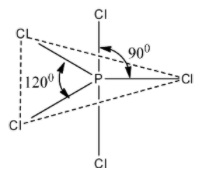Answer
35.1k+ views
Hint: Phosphorus pentachloride is the commonly abbreviated as ${\rm{PC}}{{\rm{l}}_{\rm{5}}}$. ${\rm{PC}}{{\rm{l}}_{\rm{5}}}$ has a trigonal bipyramidal structure.
Complete step by step answer:
We know that, in phosphorus pentachloride, the phosphorus is the central atom. The electronic configurations of phosphorus and chloride atoms is as follows:
Phosphorous- $\left( {{\rm{1}}{{\rm{s}}^{\rm{2}}}{\rm{2}}{{\rm{s}}^{\rm{2}}}{\rm{2}}{{\rm{p}}^{\rm{6}}}{\rm{3}}{{\rm{s}}^{\rm{2}}}{\rm{3}}{{\rm{p}}^{\rm{3}}}} \right)$ and chloride- $\left( {{\rm{1}}{{\rm{s}}^{\rm{2}}}{\rm{2}}{{\rm{s}}^{\rm{2}}}{\rm{2}}{{\rm{p}}^{\rm{6}}}{\rm{3}}{{\rm{s}}^{\rm{2}}}{\rm{3}}{{\rm{p}}^5}} \right)$
So, one of the “s”, three of the “p” and of the “d” orbitals participate to give a ${\rm{3}}{{\rm{p}}_{\rm{z}}}$ hybridisation. The five orbitals of the ${\rm{s}}{{\rm{p}}^{\rm{3}}}{\rm{d}}$ hybrid is occupies singly, so it overlaps with the ${\rm{3}}{{\rm{p}}_{\rm{z}}}$ orbital of the chlorine atom forming five sigma P-Cl bonds. This gives rise to the trigonal bipyramidal shape of the ${\rm{PC}}{{\rm{l}}_{\rm{5}}}$ molecule having the bond angles of ${90^\circ }$ and ${120^\circ }$.
We can draw the structure of ${\rm{PC}}{{\rm{l}}_{\rm{5}}}$ as follows:

The above ${\rm{PC}}{{\rm{l}}_{\rm{5}}}$ structure that we have drawn is a trigonal bipyramidal structure. Due to the trigonal bipyramidal structure, the two ${\rm{C}}{{\rm{l}}^ - }$ atoms of ${\rm{PC}}{{\rm{l}}_{\rm{5}}}$ molecule are stretched and lie along the axis and it becomes little longer and so these bonds called as axial bonds, while the other three ${\rm{C}}{{\rm{l}}^ - }$ atoms lie on equator and these bonds are called as equatorial bonds.
So, out of the given four options, A is the correct option.
Note:
Students may get confused in interpreting the structure of the ${\rm{PC}}{{\rm{l}}_{\rm{5}}}$. It should be noted that in ${\rm{PC}}{{\rm{l}}_{\rm{5}}}$, two ${\rm{P}} - {\rm{Cl}}$ bonds remains as axial bonds along the axis and the other three ${\rm{P}} - {\rm{Cl}}$ bonds remains as equatorial bonds.
Complete step by step answer:
We know that, in phosphorus pentachloride, the phosphorus is the central atom. The electronic configurations of phosphorus and chloride atoms is as follows:
Phosphorous- $\left( {{\rm{1}}{{\rm{s}}^{\rm{2}}}{\rm{2}}{{\rm{s}}^{\rm{2}}}{\rm{2}}{{\rm{p}}^{\rm{6}}}{\rm{3}}{{\rm{s}}^{\rm{2}}}{\rm{3}}{{\rm{p}}^{\rm{3}}}} \right)$ and chloride- $\left( {{\rm{1}}{{\rm{s}}^{\rm{2}}}{\rm{2}}{{\rm{s}}^{\rm{2}}}{\rm{2}}{{\rm{p}}^{\rm{6}}}{\rm{3}}{{\rm{s}}^{\rm{2}}}{\rm{3}}{{\rm{p}}^5}} \right)$
So, one of the “s”, three of the “p” and of the “d” orbitals participate to give a ${\rm{3}}{{\rm{p}}_{\rm{z}}}$ hybridisation. The five orbitals of the ${\rm{s}}{{\rm{p}}^{\rm{3}}}{\rm{d}}$ hybrid is occupies singly, so it overlaps with the ${\rm{3}}{{\rm{p}}_{\rm{z}}}$ orbital of the chlorine atom forming five sigma P-Cl bonds. This gives rise to the trigonal bipyramidal shape of the ${\rm{PC}}{{\rm{l}}_{\rm{5}}}$ molecule having the bond angles of ${90^\circ }$ and ${120^\circ }$.
We can draw the structure of ${\rm{PC}}{{\rm{l}}_{\rm{5}}}$ as follows:

The above ${\rm{PC}}{{\rm{l}}_{\rm{5}}}$ structure that we have drawn is a trigonal bipyramidal structure. Due to the trigonal bipyramidal structure, the two ${\rm{C}}{{\rm{l}}^ - }$ atoms of ${\rm{PC}}{{\rm{l}}_{\rm{5}}}$ molecule are stretched and lie along the axis and it becomes little longer and so these bonds called as axial bonds, while the other three ${\rm{C}}{{\rm{l}}^ - }$ atoms lie on equator and these bonds are called as equatorial bonds.
So, out of the given four options, A is the correct option.
Note:
Students may get confused in interpreting the structure of the ${\rm{PC}}{{\rm{l}}_{\rm{5}}}$. It should be noted that in ${\rm{PC}}{{\rm{l}}_{\rm{5}}}$, two ${\rm{P}} - {\rm{Cl}}$ bonds remains as axial bonds along the axis and the other three ${\rm{P}} - {\rm{Cl}}$ bonds remains as equatorial bonds.
Recently Updated Pages
To get a maximum current in an external resistance class 1 physics JEE_Main

If a wire of resistance R is stretched to double of class 12 physics JEE_Main

Let f be a twice differentiable such that fleft x rightfleft class 11 maths JEE_Main

Find the points of intersection of the tangents at class 11 maths JEE_Main

For the two circles x2+y216 and x2+y22y0 there isare class 11 maths JEE_Main

The path difference between two waves for constructive class 11 physics JEE_MAIN

Other Pages
when an object Is placed at a distance of 60 cm from class 12 physics JEE_Main

If a wire of resistance R is stretched to double of class 12 physics JEE_Main

Which of the following sets of displacements might class 11 physics JEE_Main

Oxidation state of S in H2S2O8 is A 6 B 7 C +8 D 0 class 12 chemistry JEE_Main

What is the pH of 001 M solution of HCl a 1 b 10 c class 11 chemistry JEE_Main

The correct IUPAC name of the given compound is A isopropylbenzene class 11 chemistry JEE_Main



